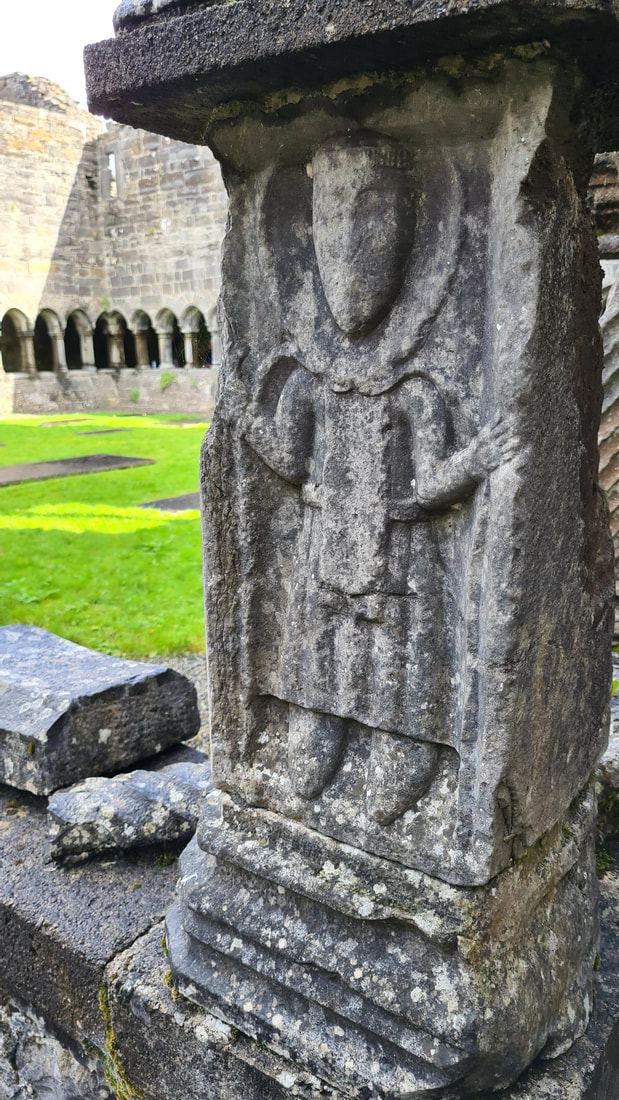|
Each first Wednesday of the month, many of the OPW heritage sites offer free admission to individual visitors and families. On one of these Wednesdays, we found ourselves visiting Sligo Abbey in Sligo town. The abbey is located in Abbey street with ample car park space available in Abbey Street car park. The Dominican friary was founded in 1253 by Maurice Fitzgerald. As many Norman towns in those days, Sligo had a castle and the abbey. Where the castle was destroyed in the 14th Century, the abbey survived. But it must be said that the abbey was rebuilt throughout its history as it suffered accidental fires and got damaged throughout local wars. We opted for the guided tour which we would highly recommend. Our guide was very knowledgeable and explained the history of the abbey in detail. Throughout Sligo abbey's history, the population of friars increased and decreased. In 1608, only one friar was left in the abbey, father O'Duane who died in that year. Prior to his dead, father O'Crean arrived from Spain and built up a new community. unfortunately, the friary deteriorated that much throughout wars that it fell in disrepair and a new friary was built. From that point onwards, the abbey grounds were used as a cemetery and the buildings were quarried for reusable stone. Luckily, a stop was put to the quarrying and parts of the abbey were saved. The first part we visited during the visit was the church which still has its tower intact. A special feature within the church is the 15th century rood screen which divides the church in two separating the nave from the choir. Within the church is the "O'Crean altar tomb" which is the oldest surviving monument within the church. On the tomb is a latin inscription that dates it to 1506 and states the tomb is fron Cormac O'Crean and his wife Johanna. Another noteworthy feature within the church is the O'Connor mural which is located right of the altar. It shows a relief of O'Connor and his wife kneeling in prayer. O'Connor was instrumental in saving the abbey from dissolution. Beside the church is the cloister of the abbey. Only three sides of the cloister remain standing; the western side has been demolished. The cloister walk is covered with rubble barrel vaults where its arcades are supported by slender pillars reminiscent of double columns. Leading from the cloister are the sacristy, vestry and chapter room which are part of the 13th -century core of the abbey. On top of these rooms is the old refectory where you can see a ruined oriel window. It is here that a friar would be seated reading aloud from the scriptures during mealtimes. During the cholera epidemic of 1832, many of the dead were buried in mass graves in the grounds of the abbey. During six weeks, 1500 people died in Sligo during this Cholera outbreak.
An interesting fact is that Bram Stoker's mother hailed from Sligo. It is thought that Bram Stoker's mother , who was haunted by the cholera outbreak she witnessed first hand, told her young son stories of the horrors she seen in Sligo. These stories echo through her son's famous novel "Dracula",... So after an interesting visit, we said our goodbyes to the guide and the group.
0 Comments
Leave a Reply. |
�
About the AuthorWe are Peter & Dolores De Bie. We love the great outdoors, discovering new parts of the world and writing about our adventures along the Wild Atlantic Way and further afield Categories
All
|
Contact us |
Where are our visitors from |
copyright © 2024 www.outdoorfitnesssligo.com
©Website design by Outdoor Fitness Sligo
©Website design by Outdoor Fitness Sligo










 RSS Feed
RSS Feed
